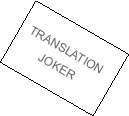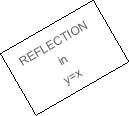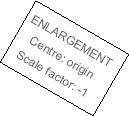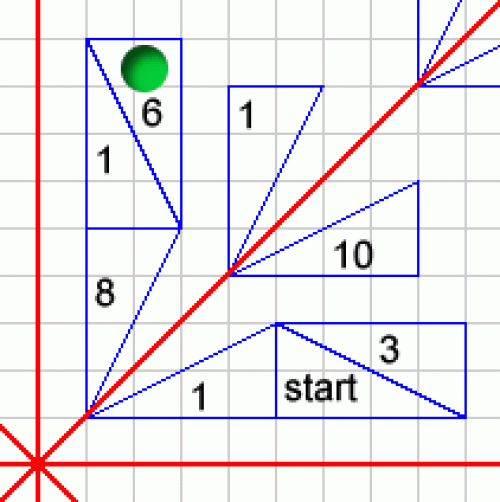Transformation game
Why not challenge a friend to play this transformation game?
Why not challenge a friend to play this transformation game?
You will need:
- Transformation Game board - print this and then enlarge onto A3 paper with a photocopier if you have access to one. Otherwise, you can print it on two sheets of A4 paper and join them together using the bigger version.
- Transformation Game Cards - print this sheet three times and cut out the cards to make a pack of 45 transformation cards.
- Image
 Image
Image Image
Image
- Counter (you could cut out a triangle to use as a counter)
- 2 - 4 players
How to play:
Shuffle the cards, deal five to each player and place the rest of the pack face down on the table. Put the counter on the triangle marked "start".
Image
Players take it in turns to move. When it is a player's turn, s/he must try to move the playing piece from where it is on the board to another of the marked triangles. S/he must use a transformation or combination of transformations corresponding to one or more of the cards in his/her hand. In the case of more than one card, the intermediate positions of the playing piece need not correspond to a marked triangle.
- When a player has moved, s/he throws away the card or cards s/he has used, and replaces it (or them) with cards from the unused pile.
- The player scores the number of points corresponding to the number on the triangle where s/he finally lands.
- If a player cannot move (or does not wish to move), s/he may throw away one card and replace it with another.
- When using a joker, a player must announce what it represents before s/he uses it.
- If a player makes a mistake, the playing piece is returned to its last position and the player at fault misses that turn.
- The game ends when the pile of unused cards is empty and no one can move. The player with the highest total score wins.
Why play this game?
This game provides an opportunity to practise a lot of transformations in the context of a game. The scoring system encourages the use of combinations of transformations. Opponents usually watch for cheating and errors, so there is built-in feedback for students. The structure of a game encourages students to play strategically.
Possible approach
Play a demonstration game, teacher vs a couple of students working together. It would be useful to have the playing board drawn or projected on the board for this. Ask students to play in pairs to get used to the game, and to make a note of any questions they might have.
With the class all together, allow time to answer the questions that have arisen.
Explain that students will be playing in pairs against other pairs, and that they will have some time to prepare. In their pairs, suggest that students ensure they know where the triangles would go, for whatever transformation card they get, and encourage them to practise making more complex transformations.
Organise a competition between pairs.
Use the time available to give positive feedback to those who get high total scores (even if they do not win) and to those who use combined transformations.
Key questions
Where can we get to from here?
How would you get to the high scoring triangles? Which cards would you need to have?
Possible support
Students might want to redesign some of the transformation instruction cards, so that the information about how to move is clearer to them. The teacher will need to decide whether they should use their own cards, or whether they could keep them visible as a reference to check the meaning of the printed cards.
Explain that the group will be playing this game in teams against the teacher later on, and that they have most of the lesson to work on strategy. Maybe kids could start with a couple of cards, then come and ask for more when they are sure that they know where each triangle would go, and then two more etc.
When a team plays the teacher, make sure that they discuss and agree on the moves.
Possible extension
Students could be restricted to moves which involve more than one transformation.
Other aspects could be altered - students could agree fair rules between themselves.
Ask students to design their own version of the game, perhaps changing the shape, the transformations on the cards and the size of the grid. They could play the game to decide what scores are appropriate for their new version.
